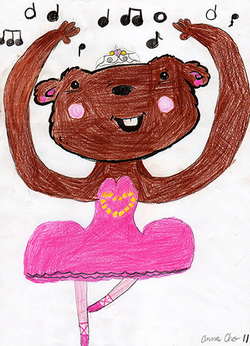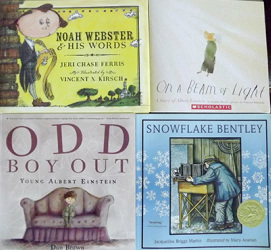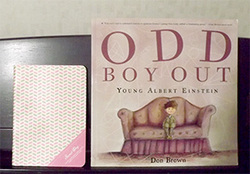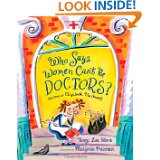 We interrupt our biography series to have a little groundhog fun. Author Susanna Leonard Hill is sponsoring a fashion show for her picture book character, Phyllis the groundhog, which you can read about here and see all the other entries. My 11 yr old daughter, Anna, drew a Ballerina Phyllis, twirling and refining the five positions of ballet while she passes the winter months in her warm burrow. Anna predicts Phyllis will say 6 more weeks of winter, because of how the polar vortex has made winter weather worse. Since there's no Groundhog Day in Korea, we like participating in this contest. Thanks, Susanna. If you'd like to see Susanna's Punxsutawney Phyllis, see below and click.
26 Comments
 The best biographies are those that peek into the heart and soul of their subject. They delve deep beneath the surface of “fact” to find the real human story. ~ Candace Fleming A neat opportunity happened a week ago. I interviewed a living descendant of the person I'm writing a picture biography about. You might be thinking--how did you find a living relative? Lots of hunting on the Internet. I really felt like a stalker! A school was named after my person and celebrating its 100th anniversary. A law paper about it listed all the living descendants! Thanks to Kristen Fulton of our WOW Nonfiction Facebook group, she suggested looking up the descendants on Spokeo.com for phone numbers and addresses. I also searched them on Facebook and found two, but they didn't answer my messages or friend requests. I don't blame them; I don't friend strangers either. White Pages.com and Anywho.com also helped me narrow down phone numbers. Then, I said a prayer, and with enough courage, called. I couldn't believe she answered the phone. She's the great-granddaughter and 88 years old. I think she was more surprised that I was calling from South Korea. We had a lovely conversation later that day, but to be honest, she didn't really give me any new information. However, she did stress some details that I thought weren't as important. So now I'm re-looking at those areas. She also told me to call another relative, which I still have to do after I do another step. I ordered in some actual books on my subject from Amazon. Otherwise, all my sources, journals and autobiographies, have been online through the Library of Congress Archives. I'm so fortunate I can research while in another country! So I'm currently reading these books, and then I'll call relative #2. I've also read from some of the experts in the picture book biography field. Kathleen Krull likes to read actual books about her subject first rather than autobiographies, journals, and diaries, because she says people can lie about themselves. She reads what the best scholars have to say about the person or topic. Candace Fleming likes to use all sorts of materials, books, Internet, newspapers, etc...plus she travels to the place her person lived. Since I can't do option #2, I'm now doing option #1. However, I started opposite Kathleen. I read all of the journals online first and am now reading what scholars said about her. And the cool thing about this--the scholars WENT to the university libraries and read all the letters and nitty-gritty that's not online. So it's like they did all the research for me. haha. And finding out what other authors said about my person is also enlightening. I'm still debating the emotional arc or heart of my biography. So it's neat to see what character qualities they picked up on. I wanted to share some expert advice from the picture book biography authors that have been useful to me. The links are below. I did write my bad first draft and have sent it to my critique groups. Now it's time to rewrite, now that I know more of the heart of my biography. Awesome interviews of Candace Fleming and Kathleen Krull on writing biographies A video interview of Tanya Lee Stone, watch "A Person's Story" Kathleen Krull has lots of links and information for authors I hope this is helpful. If you know of other helpful sources, please share.  I'm so glad last week's post was helpful to so many of you. To continue on in this subject, I'm going to skip to the endings of picture book biographies, even though it's not the end of January. As picture book biography writers, once we have our beginning sentence, we need to know how the story is going to end, that way we can build the middle. Unfortunately, the Amazon "Look" feature is no help here. But thankfully, I have some picture book biographies in my collection and ones I bought through Amazon Kindle. Just for the record, I'm no expert! I'm writing these posts mainly for my benefit as I learn this genre. I'm going to categorize the endings like I did with the beginnings, although I don't have as many to use. But bear with me, and if you have some to share, please do in the comments, and I can add them. A picture book ending should fulfill a promise that you made in the beginning. If you write about Eli Whitney and the cotton gin in the beginning, then you should end with Eli Whitney and his great invention, not with some other topic like how cotton is grown. It's called coming full circle. And I realized something else, which I'll share at the end. :) I'm first going to list the beginning and then the ending, so you can see how that ending fulfills the promise made in the beginning, plus categorize the ending so you can see ways authors have ended their biographies. Quirky Endings - the ending emphasizes the quirk or special trait that made this person unique Noah Webster and His Words by Jeri Chase Ferris, Houghton Mifflin 2012 Beginning: Noah Webster always knew he was right, and he never got tired of saying so (even if, sometimes, he wasn’t). He was, he said, “full of CON-FI_DENCE” [noun: belief that one is right] from the very beginning. Ending: Noah Webster's words did unite America. He always knew he was right! Odd Boy Out: Young Albert Einstein, by Don Brown, Houghton Mifflin 2004 Beginning: On a sunny, cold Friday in the old city of Ulm, Germany, a baby named Albert Einstein is born. It is March 14, 1879. The joy his family has for the new birth is brief. His grandmother cries, "Much too fat. Much too fat." And his mother fears his head is too big. Ending: For the world, Einstein comes to mean not fat baby, or angry child, or odd boy, but great thinker. Quirk + thanks + review of person's greatness - This ending emphasizes what the person has done, usually because of their quirky trait. Snowflake Bentley by Jacqueline Briggs Martin, Houghton Milfflin 1998 Beginning: In the days when farmers worked with ox and sled and cut the dark with lantern light, there lived a boy who loved snow more than anything else in the world. Ending: Neighbors and strangers have come to know of the icy wonders that land on their own mittens--thanks to Snowflake Bentley. Talks to the Reader Who Says Women Can't Be Doctors? The Story of Elizabeth Blackwell by Tanya Lee Stone, Christy Ottaviano (Henry Holt) 2013 Beginning: I'll bet you’ve met plenty of doctors in your life. And I’ll bet lots of them were women. Well, you might find this hard to believe, but there once was a time when girls weren’t allowed to become doctors. Ending: She had become the first woman doctor in America. Although many people were proud, others were angry. One doctor even wrote, “I hope, for the honor of humanity, that [she]will be the last.” But as you know, she certainly was NOT. On a Beam of Light: The Story of Albert Einstein, by Jennifer Berne, Chronicle 2013 Beginning: Over 100 years ago, as the stars swirled in the sky, as the Earth circled the sun, as the March winds blew through a little town by a river, a baby was born. His parents named him Albert. Ending: But still, Albert left us many big questions. Questions that scientists are working on today. Questions that someday you may answer...by wondering, thinking, and imagining. *This one also ends using Albert's quirk of always asking questions which is introduced in the middle of the book, rather than the beginning. Notice that each book emphasized in some way a quirk or trait that made the person unique for his/her greatness. AND, my realization--the illustrator emphasized that quirk on the book cover! Check it out. See Noah Webster's big head to show his pride, and with On a Beam of Light, Albert is looking at the light, with inquisitiveness, and in Odd Boy Out, Albert is all alone because he's so odd, and Snowflake Bentley is surrounded with snow, and in Who Says Women Can't Be Doctors?, it's obvious there's a GIRL on the cover? So just like when writing picture books, we're told to have a flawed main character with some quirk, the SAME thing is needed in a picture book biography. What makes this person tick? How did the flaw or special trait aid in greatness and fame? QUIRK is my word for the week. What quirk does your character have? How would an illustrator draw it?  Happy 2014! Since it's the beginning of a new year, I thought I'd talk about the beginnings of picture book biographies because that's what I've been studying lately. But first I want to share 2 little gifts from my 2 kids. They saw my Amazon Wish List where I've been adding books I wanted to read, especially biographies. They wrote down the titles, but I thought, there's no way they can get these here in Korea. But I was wrong. At the English bookstore they had Odd Boy Out. My son gave me the small notebook because I'm always buying notebooks for my writing. Now onto picture book biography beginnings. As with all picture books, the story's first line must hook you in. And with a historical book, I feel it's even more crucial. Kids usually gravitate toward fiction books, but nonfiction has become more interesting in this generation. I analyzed 15 recent picture book biographies and noticed picture book biography first lines could be categorized as follows: Think about which kinds of beginnings draw you in more. Bio + Quirk- This beginning tells you a little about the person and what makes them different or lists the quirk that makes them special. Diego Rivera was born in Mexico in a city called Guanajuato, which means land of frogs. As a boy Diego enjoyed playing with his trains, but more than anything he liked to draw. ~ Diego Rivera: His World and Ours by Tonatiuh Duncan, Abrams 2013 Setting + Quirk- This lists the setting plus the person's quirk that makes them special. In Venice of long ago, there lived a man who daydreamed in music. ~ Vivaldi and the Invisible Orchestra by Stephen Costanza, Henry Holt 2012 President Abraham Lincoln had just declared war on the Southern states seceding from the Union, and the new army needed men. When Frank Thompson saw a poster requesting recruits, he decided he would be one of them. Except Frank wasn’t his real name. In fact, Frank wasn’t a man. He was really Sarah Emma Edmonds. ~ Nurse, Soldier, Spy: The Story of Sarah Edmonds, Civil War Hero by Marissa Moss, Abrams 2011 Setting only A steamship pulls into the harbor, carrying hundreds of immigrants—and a surprise for New York City. ~ Brave Girl: Clara and the Shirtwaist Makers' Strike of 1909 by Michelle Markel, Balzer & Bray 2013 It was a cold and gray winter day when our ship docked in NYC. ~ Papa Is a Poet: A Story about Robert Frost by Natalie S. Bober, Henry Holt 2013 On a fine spring day in the Imperial Austrian City of Vienna, Wolfgang Amadeus Mozart glanced at the clock against the wall and sighed a great, long SIGH. ~ Mozart Finds a Melody by Stephen Costanza, Henry Holt 2004 It was the winter of 1775. The American Revolution had begun, and things weren’t going well for the Patriots of Boston, Massachusetts. ~ Henry and the Cannons: An Extraordinary True Story of the American Revolution by Don Brown, Roaring Book Press 2013 Quirk only There once was a boy who loved math. ~ The Boy Who Loved Math: The Improbable Life of Paul Erdos, by Deborah Heiligman, Roaring Book Press 2013 Noah Webster always knew he was right, and he never got tired of saying so (even if, sometimes, he wasn’t). He was, he said, “full of CON-FI_DENCE” [noun: belief that one is right] from the very beginning. ~ Noah Webster and His Words by Jeri Chase Ferris, Houghton Mifflin 2012 Bio only Over 100 years ago, as the stars swirled in the sky, as the Earth circled the sun, as the March winds blew through a little town by a river, a baby was born. His parents named him Albert. ~ On a Beam of Light: The Story of Albert Einstein, by Jennifer Berne, Chronicle 2013 On a sunny, cold Friday in the old city of Ulm, Germany, a baby named Albert Einstein is born. It is March 14, 1879. ~ Odd Boy Out: Young Albert Einstein, by Don Brown, Houghton Mifflin 2004 Quote + What the Person Wants “I long to be a man,” Louisa May Alcott scribbled one day, “but as I can’t fight, I will content myself with working for those who can.” Coming from a family who was part of the Underground RR, to shelter runaway slaves, she burned to help the war effort. ~ Louisa May's Battle: How the Civil War Led to Little Women by Kathleen Krull, Walker 2013 Prior Knowledge or Text to Self - This begins with children thinking about what they already know. I’ll bet you’ve met plenty of doctors in your life. And I’ll bet lots of them were women. Well, you might find this hard to believe, but there once was a time when girls weren’t allowed to become doctors. ~ Who Says Women Can't Be Doctors? The Story of Elizabeth Blackwell by Tanya Lee Stone, Christy Ottaviano (Henry Holt) 2013 What would you do if someone told you can’t be what you want to be because you are a girl? ~ Elizabeth Leads the Way: Elizabeth Cady Stanton and the Right to Vote by Tanya Lee Stone, Christy Ottaviano (Henry Holt) 2010 Problem Eleanor’s father adored his “Little golden hair.” They talked. She danced for him. He hugged her and threw her into the air. He made her feel important and loved. But he drank a lot and wasn’t home much. Eleanor’s mother thought Eleanor was ugly and too serious. She called her “Granny” in front of people. Eleanor tried to please her mother by being good. It didn’t work so she just kept quiet. “I wanted to sink through the floor in shame.” ~ Eleanor, Quiet No More by Doreen Rappaport, Disney Hyperion 2009 *** Thanks to Amazon's "Look" feature, I can study some first lines. And maybe some titles could be in more than one category, but you can see a pattern of popular categories. And if you have other first lines of picture book biographies that you'd like to add, let me know! I did all this, just so I could write MY first line on my first draft. And who knows, it could still change. I hope this might be helpful sometime in your writing future. And I was just thinking--sometimes fiction picture books' first lines also fit these categories. Happy Writing! |
Tina M. Cho, children's authorI'm a children's author and freelance writer for the educational market. Welcome! Archives
March 2024
Categories
All
|






 RSS Feed
RSS Feed
